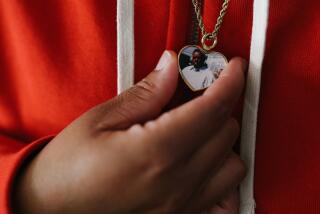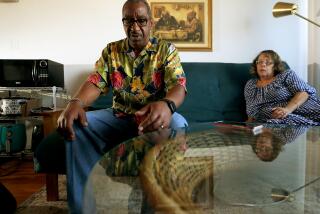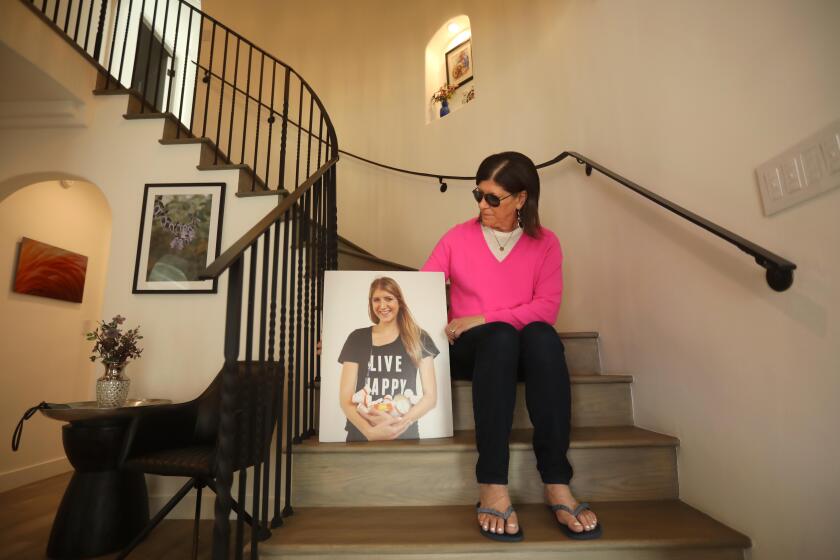Inmate’s Suicide Indicates Prison’s Ongoing Problems
Hours after being taken off suicide watch last week at Corcoran State Prison, inmate Michael van Straaten penned a farewell note to his family and fashioned a noose out of a torn bedsheet and shoelaces.
During a 3 a.m. bed check, he was found hanging in a dark corner of his cell in the prison’s infamous “hole.” But rather than pop open the cell door and determine whether he was dead or alive, prison guards remained outside for 18 minutes while his body dangled, according to a confidential prison report obtained by The Times.
No one sounded an emergency alarm. Instead, guards radioed a supervisor and proceeded to videotape the scene through the metal bars. When a lieutenant and a medical technician arrived, officers spent several minutes reviewing a prison file that revealed Van Straaten’s struggles with epilepsy and HIV.
When the officers finally did enter the cell and cut the noose, they found that his body was still warm, according to the prison report.
The suicide of Van Straaten and other incidents, including a near fatal inmate-on-inmate beating last week inside the Security Housing Unit, have set off alarm bells among top corrections officials. They say that Corcoran--after years of brutality and attempts at reform--remains an institution with problems.
Cal Terhune, state director of corrections, said Friday he was bothered by the 18-minute lapse and the fact that the officers broke policy by not sounding an emergency alarm that would have brought more immediate response.
Standard Procedure on Response
The standard procedure during any suicide incident is for a guard to sound the alarm and wait for two backups. Then they are to administer aid as quickly as possible.
Terhune said he had never heard of any prison videotaping a suicide.
“I am very concerned and my top people are very concerned about [the delay],” said the corrections director, who has asked for an internal investigation into the matter. “At this point, the burden of proof is on the [officers] to prove that there was justification for the delay.”
Terhune said the San Joaquin Valley lockup has taken important steps to improve on its record as America’s deadliest prison, a place where, between 1989 and 1995, 50 inmates were wounded or killed by guards firing rifles. Not a single serious or fatal shooting has taken place over the past three years.
But the suicide and the beating and recent state audits showing security lapses inside Corcoran’s Security Housing Unit underscore continuing problems, Terhune conceded.
Terhune confirmed that Van Straaten was pronounced dead--nearly 20 minutes after his discovery--by a physician who did not attempt to revive him.
The 32-year-old Canadian citizen was serving a life sentence for kidnapping and assault with a deadly weapon.
Prison rights advocate Judy Greenspan, who had waged a two-year battle to get Van Straaten transferred to a prison medical facility that could better treat him, said the delays were appalling.
“Whether they didn’t enter his cell because of fear of AIDS or absolute callous disregard for inmates, it’s horrendous either way,” said Greenspan, chairwoman of the HIV Committee of California Prison Focus.
“Michael should have never been at Corcoran. His death was an extreme cry for help on behalf of 230 other HIV prisoners who are housed there,” she said.
The Kings County sheriff’s coroner said he never determined an exact time of death but said that if Van Straaten was dead when guards discovered him, he had only recently expired.
“He was still limp and warm when they took him down, and that would indicate death anywhere from two hours to several minutes” previously, Sheriff’s Coroner Bill Willard said. “But I can only make a guess.”
Terhune acknowledged that prison guards failed to activate their alarms because of an unwritten rule at Corcoran that prohibits sounding alarms on the late-night first watch. The rule, dropped after Van Straaten’s suicide, was put into effect years ago after an officer twisted his ankle responding to such an alarm.
“I don’t think the warden was aware of this unwritten policy,” Terhune said. “There needs to be one statewide policy on suicide prevention and one policy on suicide response. There can’t be different policies institution by institution.”
Inmate Had History of Mental Problems
Prison rights advocates say Corcoran has become a dumping ground for HIV patients serving life sentences. Van Straaten was transferred to Corcoran in the mid-1990s after being housed at the California Medical Facility at Vacaville. Officials say he was transferred because he was too high a security risk for the medical prison.
Van Straaten had a long history of mental and physical problems, including seizures that would occasionally cause him to black out and injure himself. He contracted HIV and hepatitis C from prison tattoo needles, according to prison sources.
Greenspan said Van Straaten began writing her in 1996 complaining that his medical problems were being ignored at Corcoran. She says he told her the medications to control his seizures and HIV were delayed and sometimes denied.
Greenspan began trying to win his transfer to Vacaville, but says she ran into a bureaucratic brick wall. Van Straaten’s parents and friends in Canada began writing letters to the Department of Corrections requesting his transfer to Vacaville or a prison in Canada. The Canadian Embassy offered to act as a conduit.
A year and a half ago, Greenspan said, it appeared that Van Straaten was finally going to be granted his request. But the bus to Vacaville came and went. He grew increasingly angry and depressed, she said.
In early December, after injuring himself during an epileptic blackout, Van Straaten was placed in an administrative segregation unit for fighting, sources said. The unit is known throughout the prison as “the hole” for its tough security measures and absence of outside stimuli.
“He was left alone in his cell and that’s where he was when he found out that he had been denied once again his request for transfer,” Greenspan said.
Prison records show that Van Straaten was taken out of administrative segregation and placed in the prison’s mental health crisis unit on Dec. 4 because he was a danger to himself. He was placed in restraints for six hours before calming down. He denied any suicide fixation and was sent back to his cell in “the hole” on Dec. 8.
That night, he sat down and wrote a two-page suicide note to his family, apologizing for the years of grief he had caused them and saying that his death would help Greenspan show the prison’s cruelty, according to the official incident report.
He tore a piece of bedsheet, removed the laces from his tennis shoes and fashioned a noose. He tied a sock around his neck to prevent ligature marks. Then the 250-pound, 6-foot, 7-inch inmate strung the noose to the vent.
Correctional Officer Angela Macias, making her 3 a.m. rounds, came upon his cell around 3:12, according to the incident report. Instead of sounding her emergency alarm, which would have brought an immediate response from dozens of officers, she notified Sgt. John Denny.
Denny arrived a few minutes later and saw Van Straaten’s arms hanging limply and his blue tongue protruding, the incident report states. He notified the medical staff, radioed Lt. L.R. Peterson and waited for the lieutenant to arrive from a distant office.
For about eight minutes, the sergeant and two officers watched Van Straaten dangle on the noose. Even as the lieutenant and a medical technician arrived, no one entered the cell to determine his condition.
Instead, one of the commanding officers summoned video equipment from a distant office. For another eight minutes, Van Straaten was left hanging as officers reviewed his prison file and videotaped him and their preparations before entering the cell.
“Sgt. Denny entered Cell 46 closely followed by Officers [Homero] Garza, Macias and Lt. Peterson,” the report reads. “Lt. Peterson attempted verbal contact with inmate Lewis by shouting out his name, and he did not respond.
“Sgt. Denny pushed against inmate’s left arm and his muscles were without response; however, his skin felt warm to the touch.”
Corrections Director Terhune said that as soon as three officers arrived on the scene, they should have entered the cell. “I’m not sure what the procedures are at Corcoran,” Terhune said. “But I’m very concerned about it. “
Van Straaten’s mother, Dora, said his death would finally release him from the “hell of Corcoran.” “At least he’s free from prison now, free from all the things they did to him,” she said.
Corcoran Warden George Galaza was unavailable for comment.
State audits over the past six months have shown a number of security lapses inside the Security Housing Unit. They include a failure by the prison to check some inmate histories to safeguard against putting known enemies in the same cell.
During a state audit in August, the prison scored a 55% compliance rate with prison procedures and rules. Auditors criticized top managers for not leaving their offices and making occasional visits to the Security Housing Unit. In an October audit, the prison improved to a 72% compliance rating.
Last week, after the Van Straaten suicide, a control booth operator in the Security Housing Unit went on a food run and was replaced by an inexperienced officer, according to Terhune. The replacement allowed a gang member to return to a cell that wasn’t his.
The inmate then teamed up with a fellow gang member in the cell to beat up a third inmate. The bloodied and unconscious victim was discovered two hours later when a relative came to visit him.
Terhune said the security lapses that led to the beating are now under investigation by a corrections team in Sacramento. “There isn’t one part of this department that doesn’t need improvement, and Corcoran State Prison to me is a well-run facility, but it certainly can be improved, as the recent incidents indicate,” he said.
Meanwhile, on Wednesday, a Corcoran guard was arraigned on charges related to an alleged scheme to hire a hit man to kill his former wife. Francisco J. Gavaldon, 37, who was arrested last weekend, pleaded not guilty in Tulare County Superior Court.
In 1995, Gavaldon was among a group of Corcoran officers who donned ninja-like uniforms and rousted half-naked inmates from their cells, according to state reports.
(BEGIN TEXT OF INFOBOX / INFOGRAPHIC)
BACKGROUND
This is the latest installment in a continuing look into abuses of inmates in California’s high-tech prison system. Previous stories by reporters Mark Arax and Mark Gladstone have documented brutality by guards at Corcoran State and Pelican Bay State prisons and a practice of questionable shootings in prisons statewide. The stories are available on The Times’ Web site: https://www.latimes.com/prison.
More to Read
Start your day right
Sign up for Essential California for news, features and recommendations from the L.A. Times and beyond in your inbox six days a week.
You may occasionally receive promotional content from the Los Angeles Times.






